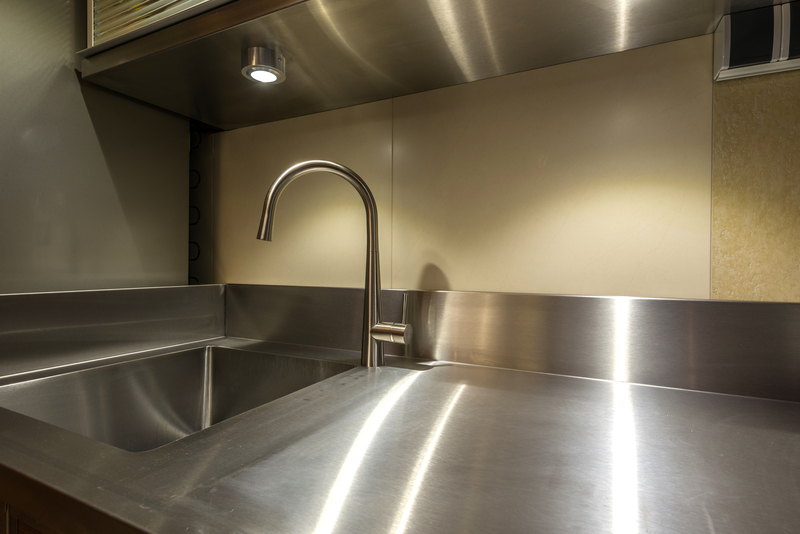Expert Tips for Eliminating Stubborn Burnt Stovetop Marks
Posted on 13/06/2025
Expert Tips for Eliminating Stubborn Burnt Stovetop Marks
Having a clean and shiny stovetop is essential for any kitchen. However, even the most careful cooks sometimes end up with stubborn burnt stovetop marks caused by spills, overflows, or forgetting a pan on high heat. These scorch marks are notorious for resisting regular cleaning methods, which can be both frustrating and unsightly. If you're looking for expert tips for removing tough burnt marks on your stovetop, this comprehensive guide is here to provide all the answers you need--with strategies, step-by-step instructions, and proactive care tips to keep your stovetop pristine.

Understanding the Causes of Burnt Stovetop Stains
Before we jump into the most effective ways to eliminate stubborn stovetop scorch marks, it's important to understand what causes these pesky blemishes:
- Overheating Cookware: When pans or pots are left unattended, they can scorch both themselves and the stovetop surface beneath.
- Spilled Food and Liquids: Boil-overs from soups, sauces, or sugary syrups can caramelize and bake onto hot stovetops.
- Use of Harsh Cleaning Tools: Scrubbing with abrasive pads can bake stains deeper into the surface, sometimes making them worse.
Knowing the root causes of burnt stains on stovetops can help you adopt preventive habits, but for those stubborn marks already present, read on for tried-and-tested cleaning methods.
Essential Supplies for Cleaning Burnt Stovetop Marks
To effectively tackle persistent burnt stovetop stains, assemble the following cleaning supplies:
- Baking Soda - Gentle yet powerful for dissolving carbonized spots.
- White Vinegar - Helps loosen grime and neutralize odors.
- Dish Soap - Cuts through everyday grease.
- Razor Blade Scraper (for glass and ceramic tops) - Safely lifts hardened residue.
- Microfiber Cloths or Soft Sponges - Non-abrasive and absorbent for gentler cleaning.
- Commercial Oven or Stovetop Cleaner - Necessary for the most persistent stains.
- Plastic Spatula - Useful for scraping less severe residues without scratching the surface.
- Rubber Gloves - Protect your hands from chemicals and heat.
Before you begin, always check your stovetop manufacturer's care instructions. What works on one type of stovetop could permanently damage another.
Step-by-Step Guide: How to Remove Burnt Marks from Any Stovetop
Glass and Ceramic Stovetops
Glass and ceramic stovetops look sleek but are especially prone to visible scorch marks. To clean them without causing damage, follow these steps:
- Allow the stove to cool completely. Tempered glass can crack if water or liquid is applied while hot.
- Wipe away loose debris with a dry microfiber cloth.
- Mix a paste of baking soda and water. Stack the paste over burnt areas and let it sit for up to 15 minutes.
- Spritz with white vinegar. The vinegar will bubble upon contact with baking soda, helping to lift residue.
- Gently scrub with a soft sponge or cloth. Work in circular motions and avoid abrasive pads.
- Use a razor blade scraper (if needed). Hold at a flat angle and gently slide beneath the marks. Never dig or gouge the glass.
- Wipe clean with a damp cloth and buff dry to restore shine.
Stainless Steel Stovetops
Stainless steel is durable, but harsh scrubbers or acidic ingredients can leave scratches.
- Apply a warm soapy cloth to the mark. Let it soak for a few minutes to soften residue.
- Sprinkle baking soda onto the stain. Gently rub using a damp microfiber cloth, always wiping in the direction of the steel grain.
- Rinse with vinegar for extra shine and stain removal.
- Dry thoroughly to prevent water spots.
- For persistent marks, use a dedicated stainless steel cleaner, carefully following instructions.
Electric Coil or Gas Burner Stovetops
Both electric coils and gas burners require different cleaning techniques:
- Remove burners or coils. Make sure they're completely cool and unplugged from power.
- Soak removable parts in hot soapy water.
- Use a nylon brush or sponge to scrub off burnt-on marks.
- For the stovetop surface itself, wipe with a mix of dish soap and warm water.
- For stubborn marks on metal pans or burner rings, try applying a baking soda paste and let it sit before scrubbing.
Alternative and Professional Tips for Stubborn Burnt-On Stovetop Stains
When DIY Natural Cleaners Aren't Enough
Some deeply burnt stovetop marks may not respond to natural remedies or require more intensive cleaning. Here's what you can try:
- Commercial Oven Cleaners: Select brands rated safe for stovetops. Follow all instructions, ventilate well, and wear gloves.
- Magic Erasers: These can be effective for ceramic and glass tops but test on a small area first.
- Lemon Juice and Baking Soda: The acidity of lemon combined with baking soda's abrasiveness can sometimes break down stubborn stains.
- Professional Deep Cleaning Services: If marks persist and you're worried about causing damage, consider calling appliance cleaning pros.
Common Mistakes to Avoid When Cleaning Stovetops
- Never use steel wool or abrasive scouring pads on glass, ceramic, or stainless steel.
- Don't soak electric elements in water - always consult your appliance manual first.
- Don't use knife blades or unsafe scraping tools--they can shatter glass or scratch metals permanently.
- Avoid harsh chemicals unless you're positive they're safe for your particular stovetop material.
- Never mix cleaners (such as ammonia and bleach) as this can release dangerous fumes.
Preventing Future Burnt Stovetop Marks
The most effective way to keep your stovetop spotless is to prevent tough burnt-on stains in the first place. Here are some top maintenance and prevention tips:
- Wipe up spills immediately--cleaning fresh spills is always easier than baked-on residue.
- Use appropriate cookware--avoid mismatched pans that could overheat on certain burners.
- Don't cook on high unattended--lower temperatures can prevent rapid burning of food.
- Invest in stovetop liners--these heat-resistant barriers can catch drips for easy clean-up.
- Deep clean monthly--regular maintenance avoids the build-up of stubborn stains.

FAQs about Eliminating Burnt Marks on Stovetops
Can I use vinegar and baking soda on any type of stovetop?
In most cases, yes; glass, ceramic, and stainless steel generally tolerate these natural cleaners well. However, always spot-test first, and avoid letting vinegar sit for long on stainless steel to prevent discoloration.
What if burnt marks have discolored my stovetop?
Some stains may discolor the finish. If the above cleaning methods fail to restore your stovetop, consult the manufacturer about replacement parts or professional restoration.
Can stubborn burnt marks be permanent?
*While most stove stains can be removed with patience and the right technique, repeated overheating or chemical damage may permanently alter the surface.* Persistent marks that have fused into the material may require professional attention.
How often should I clean my stovetop to avoid stubborn stains?
*For optimal results, wipe down your stovetop after every use and perform a deeper cleaning weekly. This prevents the gradual build-up of burnt-on marks and keeps your appliance in top condition!*
Conclusion: Restore Your Stovetop's Sparkle
Maintaining a clean stovetop doesn't have to be a losing battle. By following these expert tips for removing stubborn burnt stovetop marks--from using baking soda pastes and vinegar sprays to proper scraping and preventative care--you can restore even the grimiest cooktop to its original shine. Remember: patience is key, and regular maintenance makes cleaning effortless. Try these methods today and enjoy a spotless, gleaming kitchen centerpiece every time you cook!
Need more cleaning hacks for your entire kitchen? Browse our expert cleaning section for more tried-and-true solutions!





